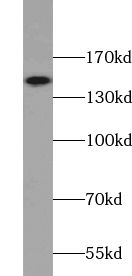Products
UBE2O antibody
| Synonyms: | (E3-independent) E2 ubiquitin-conjugating enzyme|E2/E3 hybrid ubiquitin-protein ligase UBE2O|Ubiquitin carrier protein O|Ubiquitin-conjugating enzyme E2 O|Ubiquitin-conjugating enzyme E2 of 230 kDa (Ubiquitin-conjugating enzyme E2-230K)|Ubiquitin-protein ligase O|UBE2O|KIAA1734 antibody | ||
| Catalogue No.: | FNab09181 | Reactivity: | Human, Mouse |
| Host: | Rabbit | Tested Application: | ELISA, WB |
| Clonality: | polyclonal | Isotype: | IgG |
| Size | Price |
|---|---|
| 100µg | Inquiry |
- SPECIFICATIONS
- FIGURES
- CONDITIONS
- FAQS
- Product Name
- UBE2O antibody
- Catalogue No.
- FNab09181
- Size
- 100μg
- Form
- liquid
- Purification
- Immunogen affinity purified
- Purity
- ≥95% as determined by SDS-PAGE
- Clonality
- polyclonal
- Isotype
- IgG
- Storage
- PBS with 0.02% sodium azide and 50% glycerol pH 7.3, -20℃ for 12 months(Avoid repeated freeze / thaw cycles.)
- Immunogen
- ubiquitin-conjugating enzyme E2O
- Alternative Names
- (E3-independent) E2 ubiquitin-conjugating enzyme|E2/E3 hybrid ubiquitin-protein ligase UBE2O|Ubiquitin carrier protein O|Ubiquitin-conjugating enzyme E2 O|Ubiquitin-conjugating enzyme E2 of 230 kDa (Ubiquitin-conjugating enzyme E2-230K)|Ubiquitin-protein ligase O|UBE2O|KIAA1734 antibody
- UniProt ID
- Q9C0C9
- Observed MW
- 141 kDa
- Tested Applications
- ELISA, WB
- Recommended dilution
- WB: 1:200-1:2000
 HeLa cells were subjected to SDS PAGE followed by western blot with FNab09181(UBE2O antibody) at dilution of 1:500
HeLa cells were subjected to SDS PAGE followed by western blot with FNab09181(UBE2O antibody) at dilution of 1:500
- Background
- E2/E3 hybrid ubiquitin-protein ligase that displays both E2 and E3 ligase activities and mediates monoubiquitination of target proteins(PubMed:23455153, PubMed:24703950). Negatively regulates TRAF6-mediated NF-kappa-B activation independently of its E2 activity(PubMed:23381138). Acts as a positive regulator of BMP7 signaling by mediating monoubiquitination of SMAD6, thereby regulating adipogenesis(PubMed:23455153). Mediates monoubiquitination at different sites of the nuclear localization signal(NLS) of BAP1, leading to cytoplasmic retention of BAP1. Also able to monoubiquitinate the NLS of other chromatin-associated proteins, such as INO80 and CXXC1, affecting their subcellular location(PubMed:24703950). Acts as a regulator of retrograde transport by assisting the TRIM27:MAGEL2 E3 ubiquitin ligase complex to mediate 'Lys-63'-linked ubiquitination of WASH1, leading to promote endosomal F-actin assembly(PubMed:23452853).
How many times can antibodies be recycled?
First, usually it's not suggested to recycle antibodies. After use, buffer system of antibodies has changed. The storage condition of recycled antibodies for different customers also varies. Thus, the performance efficiency of recycled antibodies can’t be guaranteed. Besides, FineTest ever conducted the antibody recycling assay. Assay results show recycling times of different antibodies also varies. Usually, higher antibody titer allows more repeated use. Customers can determine based on experimental requirements.
Notes: After incubation, we recycle rest antibodies to centrifuge tube and store at 4℃. High titer antibodies can be stored for a minimum of one week. Reuse about three times.
What are components of FineTest antibody buffer?
Components of FineTest antibody buffer are usually PBS with proclin300 or sodium azide, BSA, 50% glycerol. Common preservative is proclin300 or sodium azide, which is widely applied in the lab and industry.
How about the storage temperature and duration of FineTest antibodies?
Most antibodies are stored at -20℃. Directly-labeled flow cytometry antibodies should be stored at 2 - 8℃. The shelf life is one year. If after sales issues for purchased antibodies appear, return or replacement is available. Usually, antibodies can be still used after the one-year warranty. We can offer technical support services.
Is dilution required for FineTest antibodies? What’s the dilute solution?
Directly-labeled flow cytometry antibodies are ready-to-use without dilution. Other antibodies are usually concentrated. Follow the dilution ratio suggested in the manual. Dilute solution for different experiments also varies. Common antibody dilution buffers are acceptable(e.g. PBST, TBST, antibody blocking buffer).
How to retrieve antibodies for immunohistochemistry?
Common retrieval buffers: Tris-EDTA Buffer(pH 9.0); Citrate Buffer(pH 6.0)
Heat induced antibody retrieval:
Method 1: Water-bath heating: Put the beaker with retrieval buffer and slide in the boiling water bath. Keep the boiling state for 15min. Naturally cool to room temperature;
Method 2: Microwave retrieval: Put the beaker with retrieval buffer and slide in the microwave oven. Heat at high power for 5min, Switch OFF for 3min, Heat at medium power for 5min. Naturally cool to room temperature.
How to choose secondary antibodies?
(1) Secondary antibodies react with primary antibodies. Thus, secondary antibodies should be against host species of primary antibodies. E.g. If the primary antibody is derived from rabbit, the relevant secondary antibody should be against rabbit. E.g. goat anti rabbit or donkey anti rabbit.
(2) Choose secondary antibody conjugates according to the experimental type, e.g. ELISA, WB, IHC etc. Common enzyme conjugated secondary antibodies are labelled by HRP, AP etc. Fluorescin or dye labelled secondary antibodies are applied in immunofluorescence and flow cytometry(e.g. FITC, Cy3).
